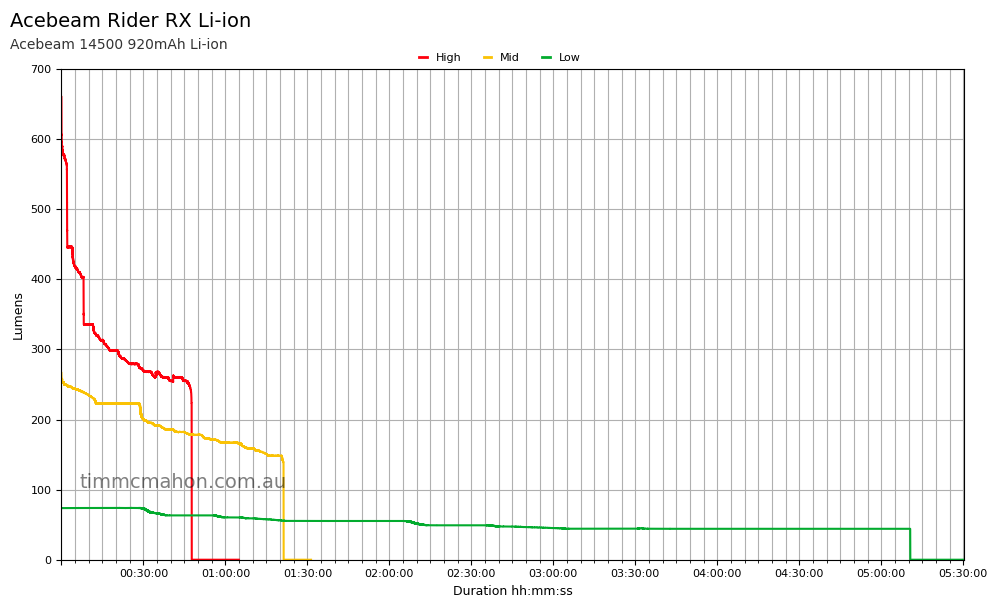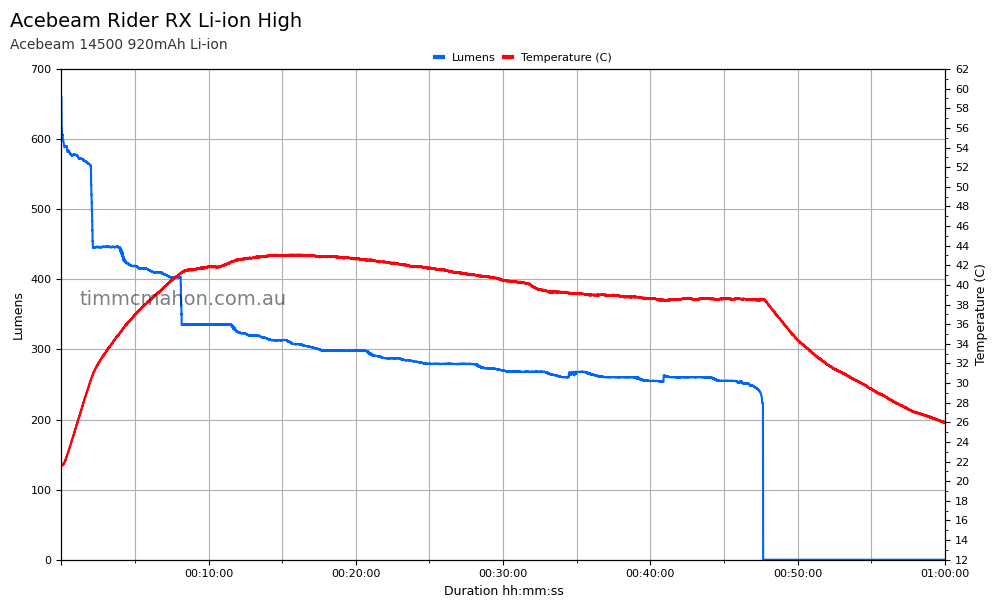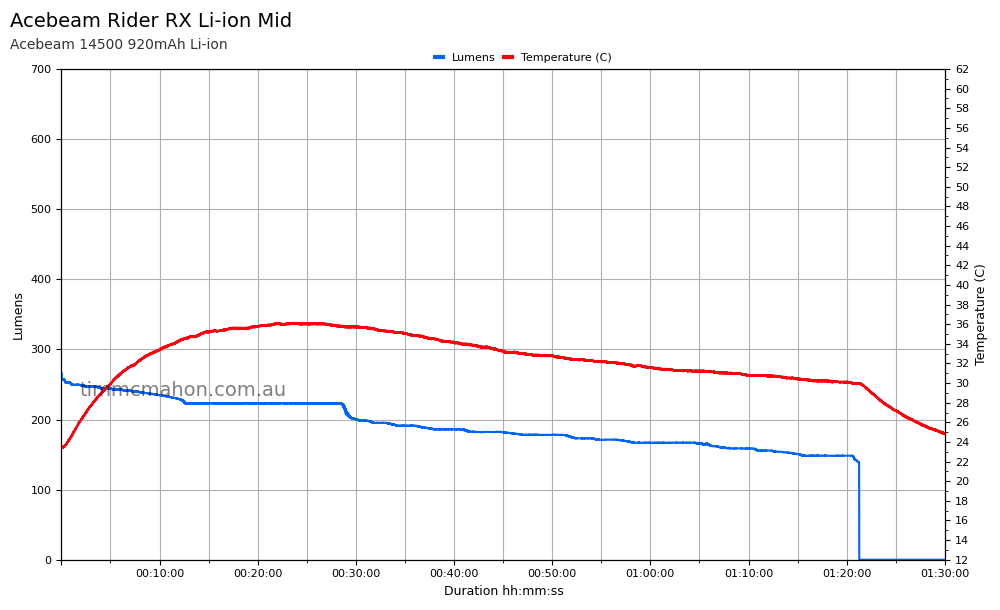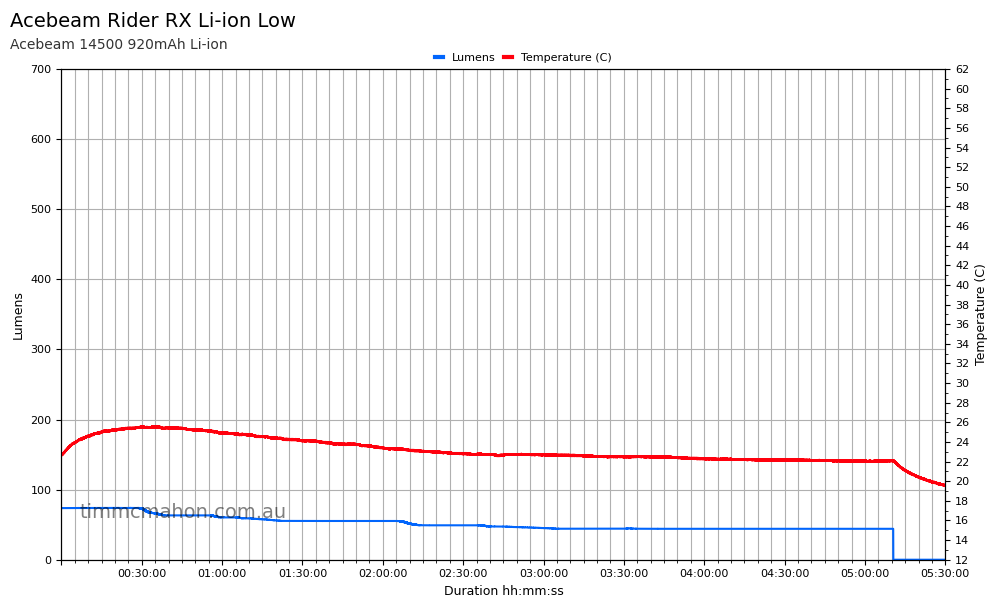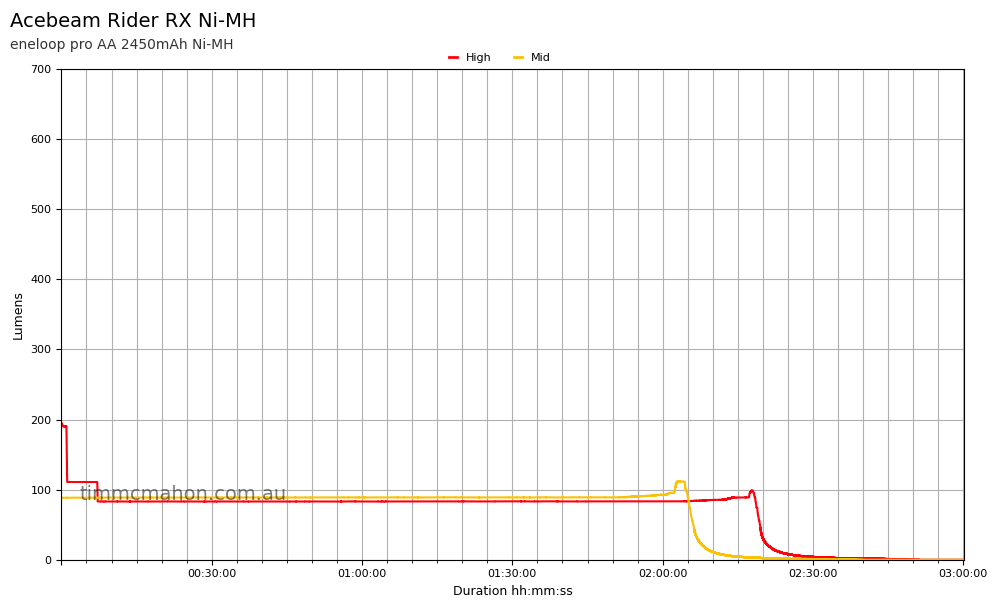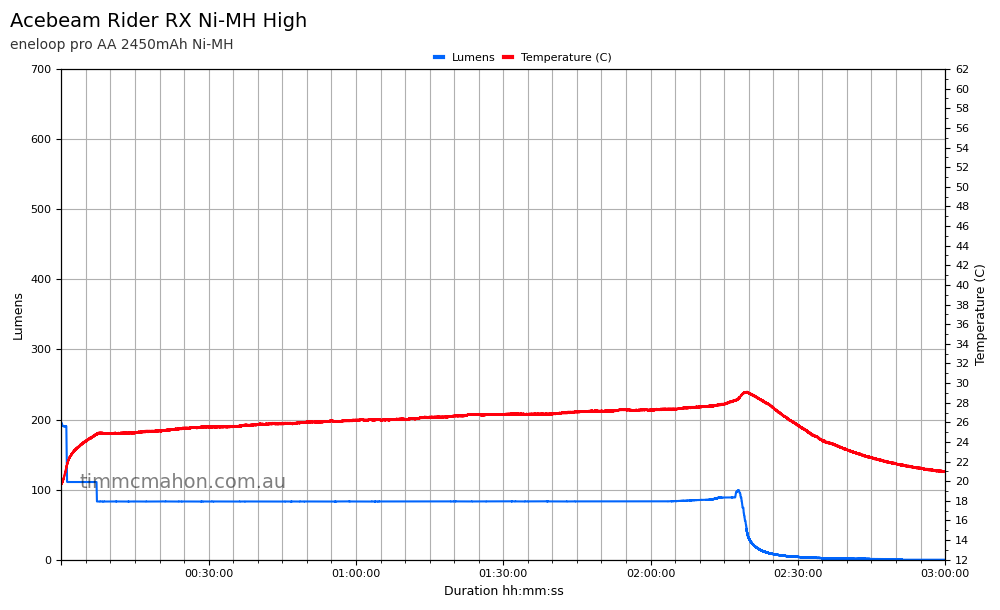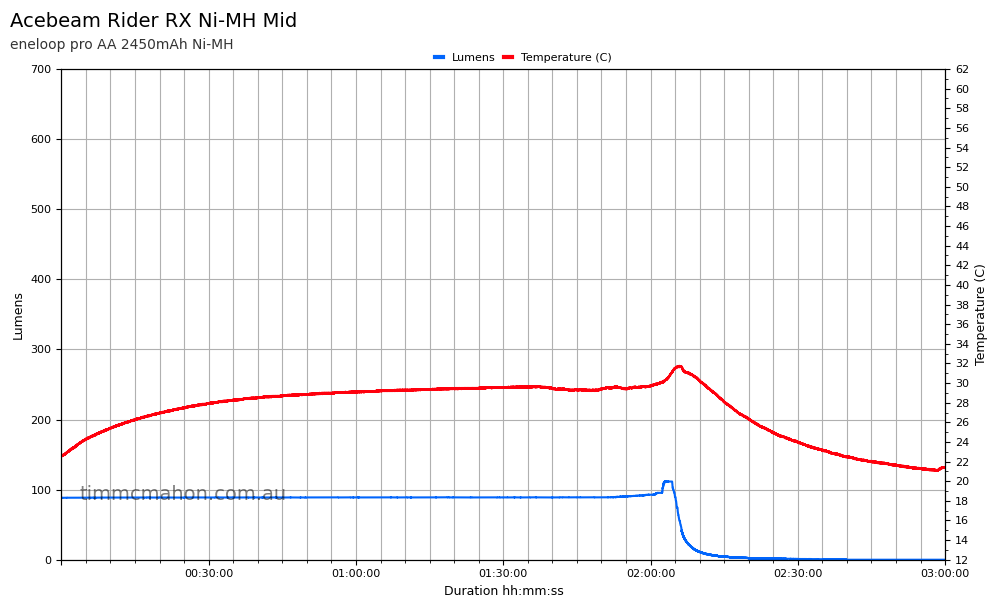Acebeam Rider RX Rainbow PVD Review
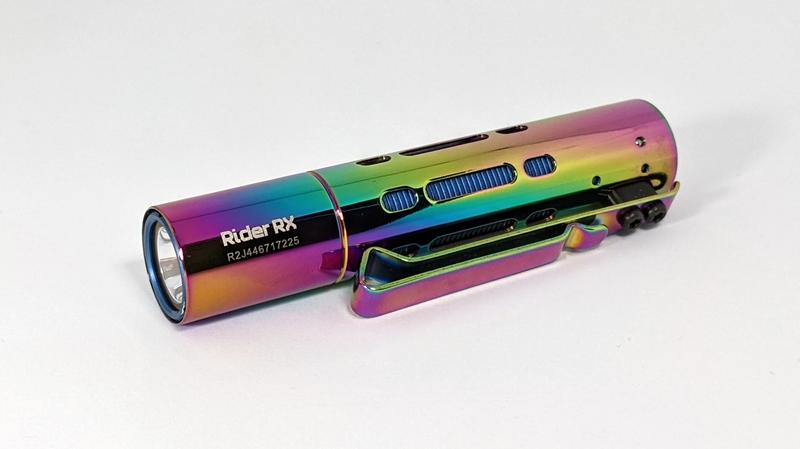
Acebeam Rider RX Rainbow PVD#
- Specifications
- Introduction
- Torch in use
- Build quality
- LED, bezel, lens, reflector and beam
- Size and comparison
- User interface and driver
- Batteries and charging
- Performance
- Beamshots
- Conclusion
- Product page
Specifications#
| Brand/model | Acebeam Rider RX Rainbow PVD |
|---|---|
| LED | Nichia 219F |
| Maximum lumens | 650 lm |
| Maximum beam intensity | 2,304 cd |
| Maximum throw | 96 m |
| Battery | 1*14500 Li-ion, 1*AA Ni-MH, 1*AA Alkaline |
| Onboard charging | No. Acebeam 14500 Li-ion cell has USB-C charging. |
| Material | Aluminium. Stainless Steel outer shell. |
| Modes | 4 |
| Blinkies | SOS |
| Reflector | Smooth |
| Waterproof | IP68 |
| Review date | April 2022 |
Introduction#
The Rider RX by Acebeam is one of the first fidget torches on the market. It is available in a variety of metals and colours.
Acebeam hosted a giveaway on Instagram and I was selected as a winner. I asked for the Rainbow PVD (Physical Vapor Deposition) version due to how gorgeous it looks.
I am a big fan of small EDC torches with tactical forward clicky buttons, and I am curious to see how much fun the fidget feature adds.
Packaging#
The Rider RX came in a small white retail box with a window to see the rainbow colours shine.
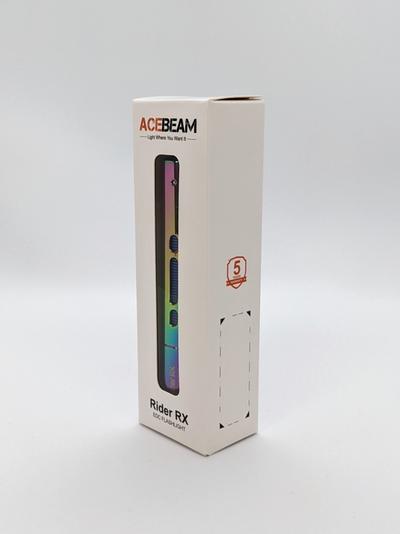
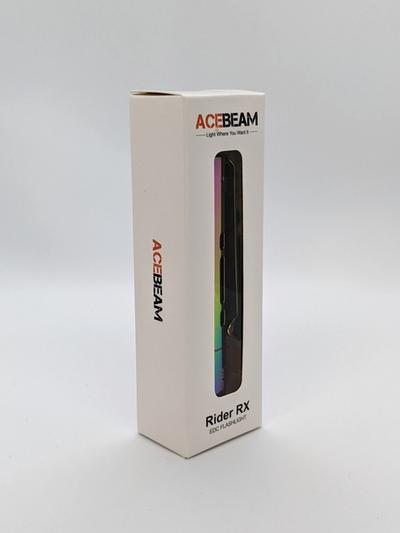
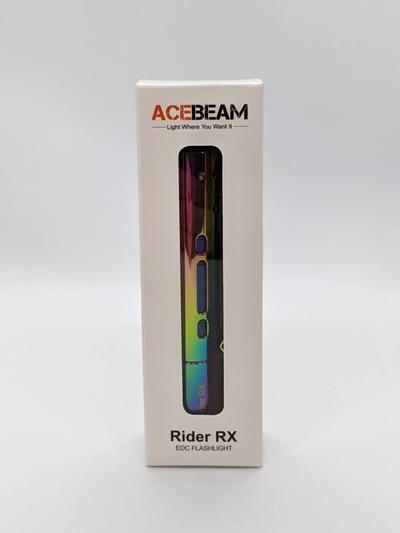
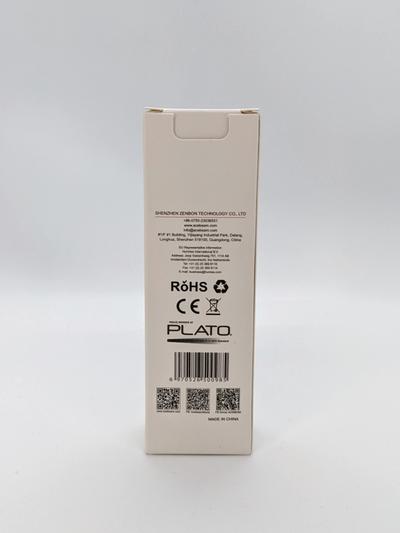
The following was included in the box:
- Acebeam Rider RX Rainbow PVD
- Acebeam 14500 920mAh Li-ion cell
- Acebeam lanyard
- Spare o-rings
- USB-A to USB-C cable
- User manual
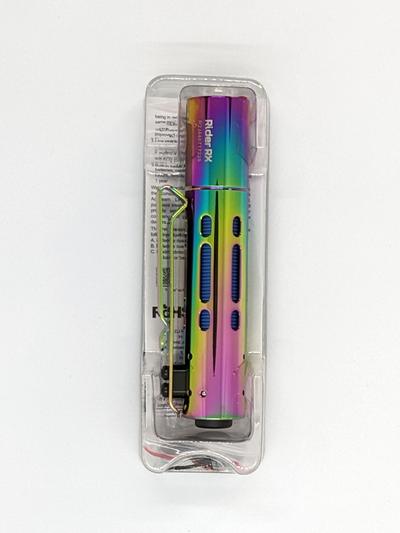
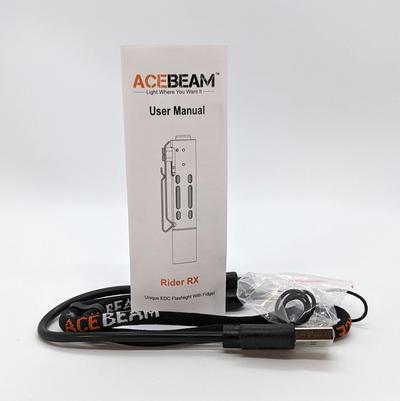
Torch in use#
The Rider RX Rainbow PVD is smooth and comfortable to hold in a moderately sized hand. There are no sharp edges.
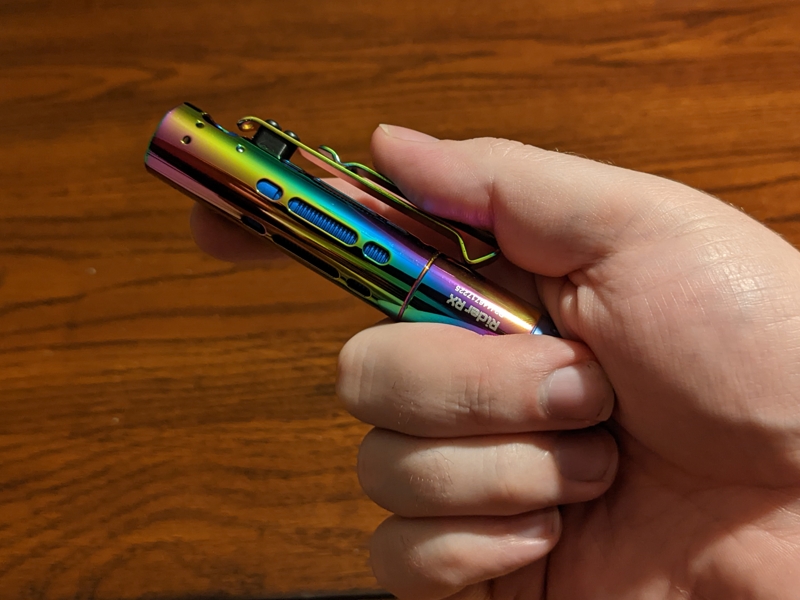
There is a small lanyard hole on the pocket clip.
A forward clicky tailswitch with a smooth CNC’d aluminium switch cover has been used. The spring in the switch has a decent amount tension while pressing it. The torch turns on momentarily while half pressing the switch and I can cycle through the modes by quickly half pressing or quickly fully clicking multiple times.
The pocket clip is massive relative to the size of the torch. The torch may be a little bit too heavy to attach to a hat using the reverse side of the pocket clip. It is not going to roll anywhere with the pocket clip.
A protruding button on a small EDC torch usually prevents tailstanding. However, this is not your average EDC torch. I can make the Rider RX tailstand by first turning it on, pushing the pocket clip to the side and down so that the button is hidden, and the head of the torch is exposed, and then by placing the Rider RX upright on a surface.
The fidget feature consists of being able to move the pocket clip from side to side and slide the pocket clip down. Ball bearings make a satisfying click into little holes while fidgeting.
It is a bit difficult to clean the Rider RX. I put the torch in a pocket with some dirt and the fidget mechanism became very gritty. I had to find a T9 screw bit, unscrew the two screws holding the pocket clip on, pop the inner tube out, and wipe the dirt off the inside of the outer shell and off the inner tube.
Build quality#
Rainbow PVD is gorgeous! This is my first Acebeam torch and I am absolutely impressed with the build quality.
Attention to detail has not gone unnoticed. The bezel around the tailswitch has a purple and blue finish to suit the overall look and feel.
The outer shell and pocket clip are made of stainless steel while the main tube and head is made of aluminium.
Copper threads on the head have been lightly lubricated and it is smooth to unscrew.
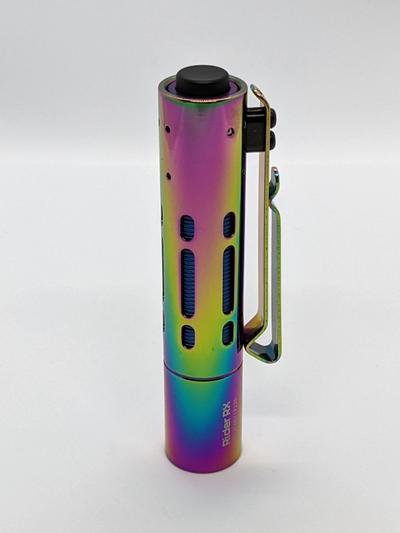
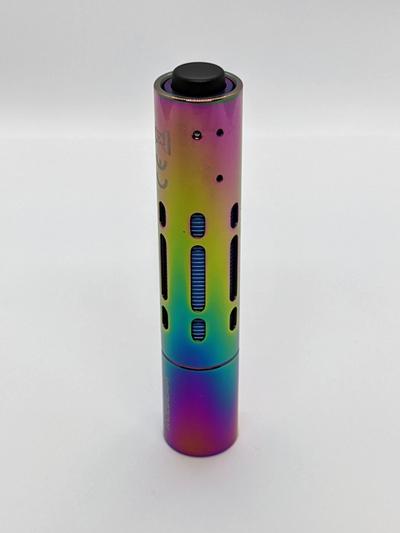
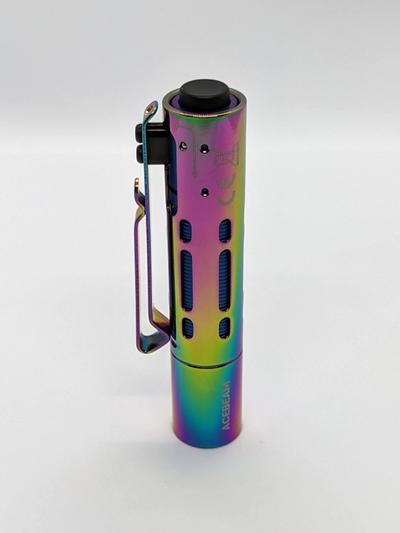
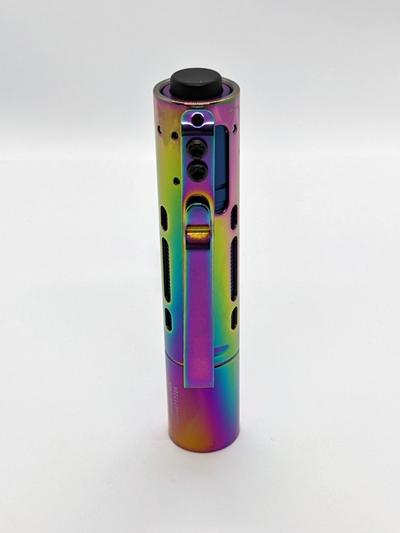
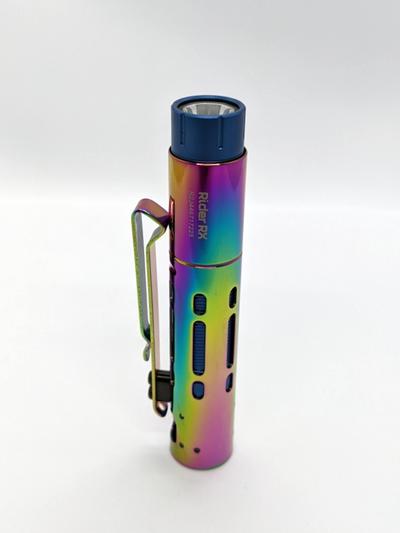
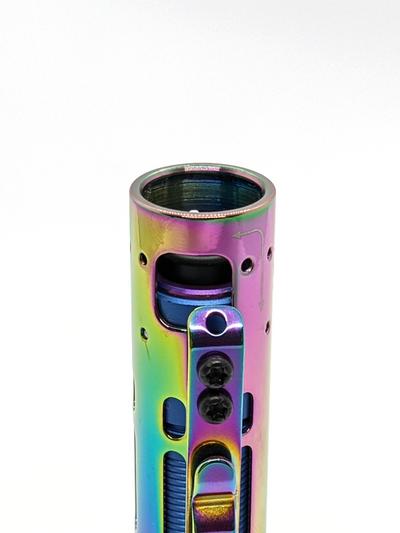
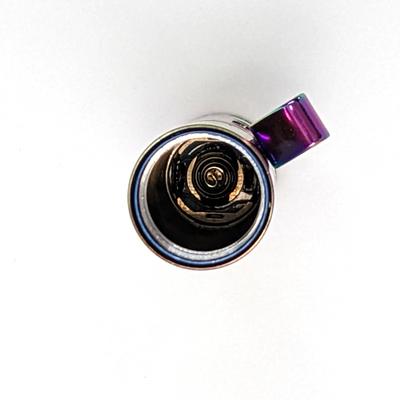
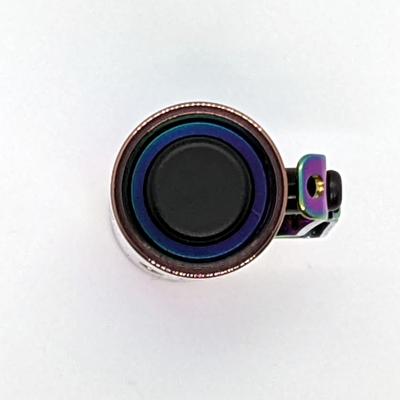
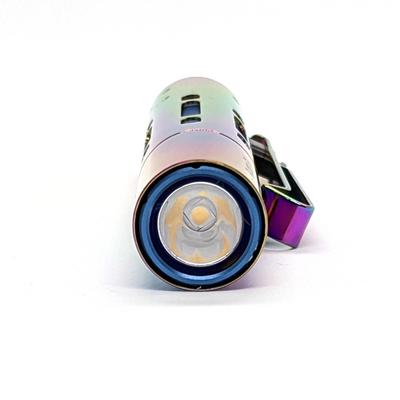
LED, bezel, lens, reflector and beam#
The Rider RX has a single Nichia 219F LED with a smooth reflector and a centering ring.
I have taken Correlated Colour Temperature (CCT) and Colour Rendering Index (CRI, RA of R1-R8) measurements with the Rider RX positioned one metre away from an Opple Light Master Pro III (G3).
The CCT is about 4700K and it is 90+ CRI.
The Delta u, v is slightly positive (green) on lower modes but it is very neutral on mid and high modes.
I like the neutral tint. The hotspot has a slightly square shape like some of my other small EDC torches.
| Mode | Lux (lx) | CCT (K) | CRI (Ra) | x | y | Duv |
|---|---|---|---|---|---|---|
| Li-ion Ultra-Low | 51 | 4490 | 96.0 | 0.3622 | 0.3695 | 0.0024 |
| Li-ion Low | 394 | 4747 | 94.3 | 0.3539 | 0.3677 | 0.0045 |
| Li-ion Mid | 1447 | 4746 | 93.9 | 0.3536 | 0.3648 | 0.0032 |
| Li-ion High | 3292 | 4755 | 93.4 | 0.3525 | 0.3575 | 0.0001 |
| Ni-MH Ultra-Low | 13 | 4425 | 93.7 | 0.3641 | 0.3679 | 0.0010 |
| Ni-MH Low | 79 | 4531 | 95.3 | 0.3609 | 0.3692 | 0.0027 |
| Ni-MH Mid | 467 | 4649 | 94.9 | 0.3571 | 0.3691 | 0.0040 |
| Ni-MH High | 1003 | 4640 | 94.7 | 0.3571 | 0.3665 | 0.0028 |
Calculate Duv from CIE 1931 xy coordinates
Dimensions and size comparison#
Dimensions#
I took the following measurements using digital callipers.
| Measurement | Unit (mm) |
|---|---|
| Torch length | 96.0 |
| Torch length while extended | 103.7 |
| Tube diameter | 18.6 |
Weight#
I took the following measurements using a digital scale.
| Measurement | Unit (g) |
|---|---|
| Weight of torch with battery | 81.4 |
| Weight of torch | 59.8 |
| Weight of battery | 21.6 |
EDC size comparison with its competition#
The Rider RX is not the shortest AA/14500 torch but it is one of the narrowest AA/14500 torches that I have.
From left to right: Lumintop FWAA TiCu, Sofirn SP10 Pro, Acebeam Rider RX Rainbow PVD, Olight i3T Brass, ReyLight Pineapple Mini Ti Stonewashed
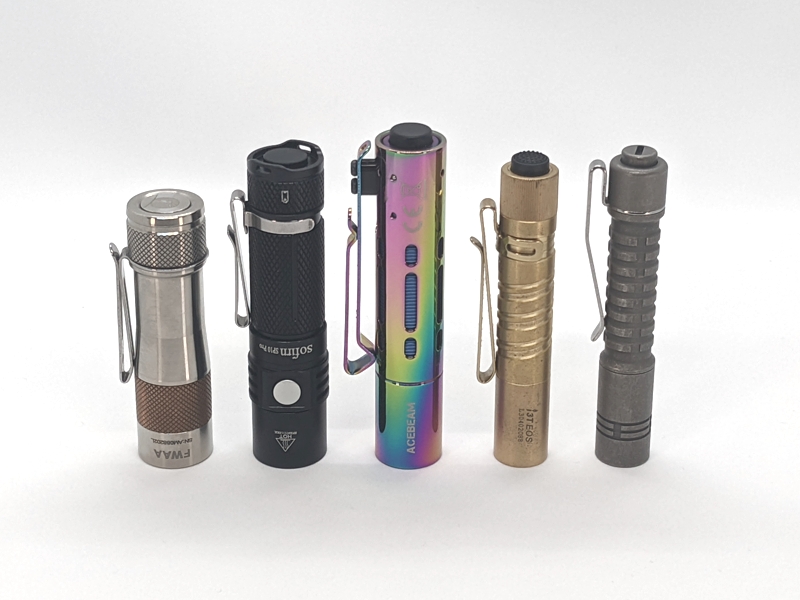
User interface and driver#
The Rider RX has a simple user interface where you can cycle between Ultra-Low, Low, Mid and High by momentarily pressing the forward clicky button quickly or by fully pressing. If you cycle through every mode twice, then you will access the SOS mode.
The driver has physical reverse polarity protection to prevent damage when a cell is inserted in the wrong direction. This may prevent flat top batteries from being used.
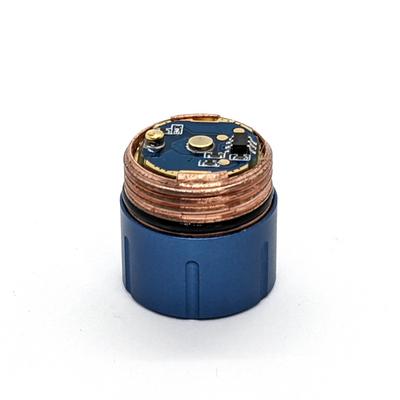
| State | Action | Result |
|---|---|---|
| Off | Click | On (mode memory) |
| Off | Momentarily click within one second of the previous momentary click | Cycle (Ultra-Low, Low, Mid, High) |
| On | Click | Off |
| On | Click within one second of the previous click | Cycle (Ultra-Low, Low, Mid, High) |
Low voltage protection#
The Rider RX does not appear to have low voltage protection. The included 14500 cell has low voltage protection.
SOS#
Cycle through Ultra-Low, Low, Mid, High twice to access SOS mode.
There is a slightly longer pause between S-O and S.
PWM#
I noticed visible PWM when the battery was almost empty.
What I like about the UI#
- Simple.
- Forward clicky.
- Momentary on.
What could be improved#
- Strobe could be added.
- Direct access to Strobe and SOS from off would be nice.
Batteries and charging#
Battery#
The Rider RX supports button top AA/14500 batteries with multiple chemistries, including: Li-ion, Ni-MH and Alkaline.
A button top Acebeam 14500 920mAh cell with built-in USB-C charging was included inside the Rider RX. The cell arrived with a voltage of 3.835V, and it was isolated with a piece of plastic to avoid standby drain.
A capacity of 939 mAh was measured using Capacity Test mode at 250mA with a Vapcell S4 Plus.
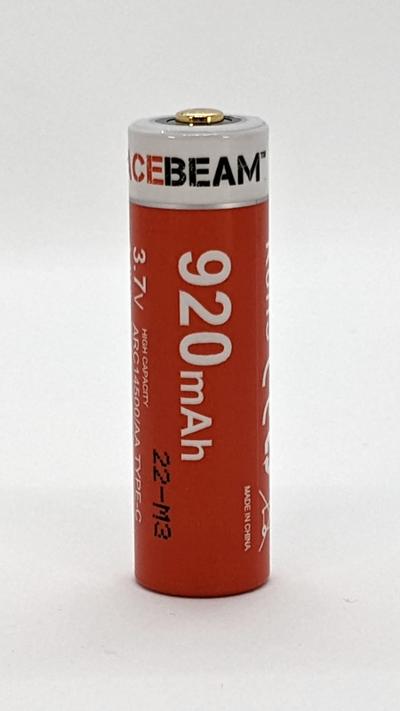
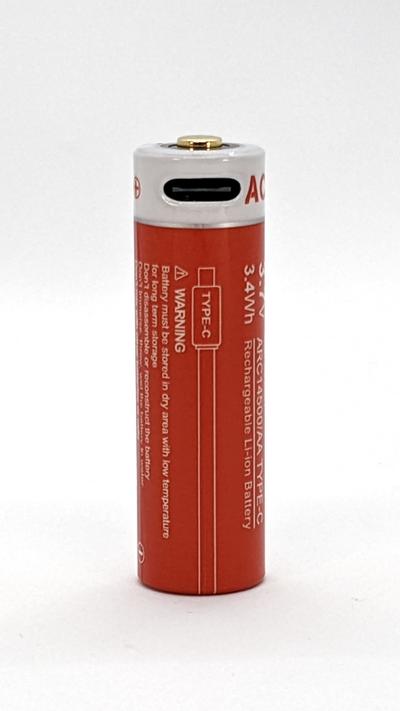
Charging#
I tried to charge the Acebeam 14500 920mAh cell using the following power supplies:
| Power supply | USB Type | Protocol | Does it charge? |
|---|---|---|---|
| Apple 61W Power Adapter | USB-C | PD | No |
| Google Pixel Power Adapter | USB-C | PD | No |
| Generic 5V 2.4A Power Adapter | USB-A | Yes | |
| Xiaomi PB100DZM | USB-C | PD | No |
| Xiaomi PB100DZM | USB-A | Yes | |
| XTAR PB2S | USB-C | PD | No |
| XTAR PB2S | USB-A | Yes |
Performance#
Official specifications from the manual:
Li-ion Battery
| FL1 Standard | High | Mid | Low | Ultra-Low | SOS |
|---|---|---|---|---|---|
| Light Output | 650~450~330 lumens | 280 lumens | 70 lumens | 7 lumens | 450 lumens |
| Runtime | 2min+6min+55min | 60min | 3h 8min | 53h | 60min |
Ni-MH Battery
| FL1 Standard | High | Mid | Low | Ultra-Low | SOS |
|---|---|---|---|---|---|
| Light Output | 200~150~85 lumens | 80 lumens | 5 lumens | 0.5 lumens | 150 lumens |
| Runtime | 1min+6min+120min | 130min | 24h | 7 days | 1h 8min |
Alkaline Battery
| FL1 Standard | High | Mid | Low | Ultra-Low | SOS |
|---|---|---|---|---|---|
| Light Output | 200~150~85 lumens | 80 lumens | 5 lumens | 0.5 lumens | 150 lumens |
| Runtime | 1min+6min+35min | 52min | 24h | 7 days | 30min |
Lux Meter: UNI-T UT383BT
DMM: UNI-T UT139C has been used to measure current under 10A.
Lumen measurements#
| Mode | Amps at start | Specs | Lumens @turn on | Lumens @30 sec | Lumens @10 min |
|---|---|---|---|---|---|
| Li-ion Ultra-Low | 0.04 A | 7 lm | 10 lm | 10 lm | 10 lm |
| Li-ion Low | 0.23 A | 70 lm | 74 lm | 74 lm | 74 lm |
| Li-ion Mid | 0.75 A | 280 lm | 266 lm | 253 lm | 235 lm |
| Li-ion High | 2.38 A | 650 lm | 660 lm | 582 lm | 335 lm |
| Ni-MH Ultra-Low | 0.04 A | 0.5 lm | 2.6 lm | 2.6 lm | 2.6 lm |
| Ni-MH Low | 0.36 A | 5 lm | 16 lm | 16 lm | 16 lm |
| Ni-MH Mid | 1.72 A | 80 lm | 88 lm | 88 lm | 89 lm |
| Ni-MH High | 3.90 A | 200 lm | 195 lm | 190 lm | 83 lm |
Standby drain#
A mechanical forward clicky switch has been used so there is no standby drain.
Runtime graphs#
I built a lumen tube and forked bmengineer’s project RuTiTe to add support for a VEML7700 light sensor and MCP9808 temperature sensor with help from Owen. Calibration lights from maukka were used.
Note: Lumen measurements may be off by more than 10% with my DIY lumen tube.
I love how Acebeam have tried to be transparent by including a breakdown of when the light output steps down for High modes. Instead of simply saying that High will last an hour, Acebeam has stated that High will start at 650 lumens and last 2 minutes before stepping down to 450 lumens for 6 minutes etc.
The Rider RX switched off when the Acebeam 14500 920mAh Li-ion cell reached 3.07V and the eneloop pro 2450mAh Ni-MH cell reached 0.81V at the end of each runtime test.
Li-ion High started at 660 lumens, dropped to 454 lumen after 2 minutes, dropped to 335 lumens after 8 minutes, dropped to 255 lumens after 46 minutes and then switched off.
Li-ion High and Mid modes lined up with Acebeam’s runtime estimates.
Li-ion Low lasted more than 5 hours, passing Acebeam’s estimate of 3 hours 8 minutes.
Ni-MH High and Mid modes lined up with Acebeam’s runtime estimates.
Throw#
I took lux measurements with a UT383BT at 30 seconds for each. Li-ion Ultra-Low, Ni-MH Ultra-Low, and Ni-MH Low were measured at one metre. All other modes were measured at five metres.
| Mode | Specs (cd) | Specs (m) | Candela measured (cd) | Distance (m) |
|---|---|---|---|---|
| Li-ion Ultra-Low | - | - | 37 | 12 |
| Li-ion Low | - | - | 225 | 30 |
| Li-ion Mid | - | - | 1075 | 66 |
| Li-ion High | 96 | 2,304 | 2,750 | 105 |
| Ni-MH Ultra-Low | - | - | 7 | 5 |
| Ni-MH Low | - | - | 62 | 16 |
| Ni-MH Mid | - | - | 300 | 35 |
| Ni-MH High | - | - | 750 | 55 |
Beamshots#
5000K WB, 1/3 shutter speed, ISO 100
Li-ion Ultra-Low, Low, Mid, High




Ni-MH Ultra-Low, Low, Mid, High




Conclusion#
The Rider RX is a fun fidget torch! The build quality is wonderful. The tint is nice. I highly recommend getting an Acebeam Rider RX in a design that appeals to you.
Pros:#
- Rainbow PVD looks gorgeous.
- Fun fidget feature.
- Wonderful build quality.
- Neutral tint.
- Multiple battery chemistries are supported (Li-ion, Ni-MH, Alkaline).
Cons:#
- No low voltage protection built into the torch.
- USB-C to USB-C charging does not work with the included 14500 battery.
- Difficult to clean the fidget mechanism if dirt gets inside.
